Monday, March 12th 2012

Microsoft Demos Super-Responsive Touchscreen with 1 ms Latency
Finger-lag is one specification buyers of touchscreen devices such as tablets and smartphones don't pay too much attention to. Finger-lag is a phenomenon when it takes a short but noticeable amount of time for a touchscreen-enabled device to respond to a touch interaction in progress (such as drawing something in a paint program, dragging an object around, etc.). Microsoft sought to address the issue by developing a new touchscreen technology that reduces latency to 1 ms, delivering much more responsive touchscreen interactions. Paul Dietz at Microsoft's Applied Science division has managed to lower touchscreen latency to 1 ms, in comparison, touchscreens in the market typically have 100 ms. The technology can also be applied to high-precision stylus-based devices such as graphics tablets, where touch-latency can affect the quality of graphics work.A video of the technology at work follows.
Source:
TechCrunch


11 Comments on Microsoft Demos Super-Responsive Touchscreen with 1 ms Latency
But I guess you know that already and just kidding.. ;)
With touchscreen-to-processor interface, nVidia DirectTouch technology (with Tegra 3) sort of achieves(albeit to a lesser degree) of what Microsoft is researching. Tegra 3 has the additonal 5th core( called SMP symmetric multi-processing) which replaces the separate analog-to-digital controller found outside a processor.
nVidia claims lower costs & power consumption without the need for separate controller and more importantly, it can process significantly more input signals/samples-per-second over current designs.
I like that more research is being done at touchscreen latency...
In my experience it's the precision of a touch-enabled device that's the limiting factor to productivity, not response time. Just look at all the comparisons of Android keyboards. Although the various swipe motions could use a response time boost, in my opinion if it's not accompanied by a equivalent increase in precision users are just going to find themselves more rapidly frustrated that the UI didn't type/swipe/do what they wanted, and it may respond too fast to figure out what went wrong, ie didn't swipe far enough or from the right place, etc. Hold-and-move motions are particularly egregious.
In short, cool, but not the biggest issue here.
This latency has been the main problem so far.
Just make it available at portable monitors and audio-capable laptops SOON
Ideally team this tech with recent USB powered (low consumption) portable monitors and vendors will have a winner.
Normal audio coding uses 44.100 samples per second, where good video needs just 30 fps.
Conversely, 20 ms differences in sound are easily audible, and trained ears (like from percussion or rhythmic musicians) had claimed listening differences of 3ms or even less...
For Dj mixing the sharp attack of kick drums sounds might cause beat smearing if there are over 6 ms delay between mixing sources.
With the exponential growth of home Djs, touchscreen DJ systems mght flourish quite rapidly. The software and the media channels are already there... waiting... :D